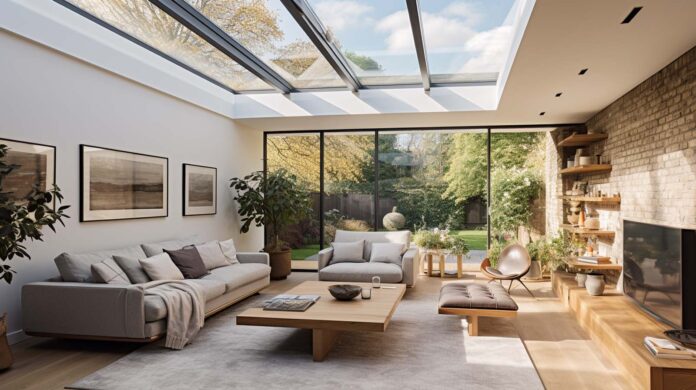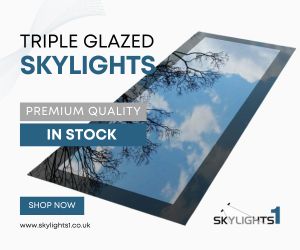Framed skylights, as their name suggests, are skylights crafted within a frame, which can be made from various materials like aluminium, wood, or vinyl. They serve as a portal for natural light and also provide an extra dash of style, enhancing the overall aesthetics of any space.
Beyond their visual appeal, framed roof windows play a significant role in creating an energy-efficient, comfortable, and healthy living environment. They facilitate ample natural light that aids in maintaining our circadian rhythm, provide the option for natural ventilation, and, by their very nature, reduce reliance on artificial lighting – a step towards reduced energy consumption. Throughout this article, we’ll delve into the realm of framed rooflights, exploring their potential to transform spaces from ordinary to extraordinary.
Understanding Framed Skylights
Explanation of What Framed Skylights Are
Framed skylights are architectural features that sit within a solid frame structure, acting as windows to the sky. Designed for both functional and aesthetic purposes, they bring the outdoors inside, allowing an influx of natural light while providing a visual connection to the sky above. Framed rooflights come in varying shapes, sizes, and designs, offering a unique way to brighten interiors and add architectural intrigue to a space.
Different Types of Framed Skylights
There are various types of framed skylights, each with its unique benefits. Fixed skylights, as the name suggests, are stationary and primarily meant to provide light. Ventilated skylights, on the other hand, open either manually or automatically to provide ventilation along with light. Additionally, you might find solar-powered skylights, custom-designed skylights, and tubular skylights, all framed to provide structural rigidity and durability.
Typical Materials Used for Frames
Framed skylights usually come in three common materials: vinyl, wood, and aluminium. Vinyl framed roof windows are highly energy-efficient, require minimal maintenance, and resist condensation. Wood frames offer a classic, warm aesthetic but require regular upkeep. Aluminium frames are the most durable and resistant to weather conditions, but they conduct heat and cold, which might affect energy efficiency. Your choice of frame material will largely depend on your design preferences, budget, and the specific performance characteristics you’re looking for in a skylight.
The Role of Framed Skylights in Architecture
Historical Use of Framed Skylights
Historically, framed skylights have been a significant feature in architecture, tracing back to ancient Roman times. They were employed in public baths and wealthy homes to maximize natural light and air circulation. In the 19th century, with the advent of industrialization, large framed rooflights became a central feature in factories and warehouses. They provided abundant daylight for workers and helped save on energy costs.
Modern Architectural Trends Featuring Framed Skylights
In modern architecture, framed skylights are not just functional elements; they’re design statements. They’re increasingly featured in green and sustainable building designs to optimize natural light and improve energy efficiency. Large, expansive framed skylights are seen in commercial buildings, like shopping centres and offices, to create a sense of openness and connection with the sky. On a smaller scale, they are used in residential designs for similar reasons, often becoming the main attraction in living rooms, kitchens, and bathrooms.
How Framed Skylights Fit into Different Architectural Styles
Framed skylights are versatile and fit seamlessly into a wide range of architectural styles. In modern and contemporary designs, they are often large, minimalist, and geometric to align with the clean lines and open spaces of these styles. In traditional homes, smaller, more ornate framed rooflights can add charm and character. Industrial designs may feature framed roof windows with dark metal frames to complement the raw, unfinished aesthetics of the style. Ultimately, the design and placement of framed skylights should reflect the overall architectural theme and enhance the visual harmony of the building.
Benefits of Framed Skylights
Natural Light and Health Benefits
Framed skylights provide an abundance of natural light, offering several health benefits. Increased sunlight exposure during the day can help regulate sleep-wake cycles, increase vitamin D production, and boost mood. Sunlit spaces can feel more inviting and comfortable, leading to improved productivity and overall well-being.
Energy Efficiency and Environmental Impact
Framed skylights are a critical element in energy-efficient building design. They can dramatically reduce the need for artificial lighting during the day, cutting down on energy consumption. Additionally, skylights can contribute to passive solar heating in the winter and, when used with appropriate blinds or shades, can mitigate heat gain in the summer. This reduction in both lighting and heating/cooling energy needs leads to lower carbon emissions, playing a part in mitigating climate change.
Enhancing the Aesthetics of a Space
From an aesthetic perspective, framed skylights can transform a space. They can introduce an architectural focal point and enhance the overall design of a room. Skylights can also bring in the dynamic play of sunlight and shadow throughout the day, adding to the visual interest of the space. The frames themselves, available in a variety of materials and finishes, can align with different design themes, adding an additional layer of customization and aesthetic appeal.
Selecting the Right Framed Skylight
Factors to Consider
Selecting the right framed skylight requires careful consideration of several factors. The size and shape of the skylight will significantly impact the amount of light admitted and the aesthetic appeal. The location is also crucial – a skylight should be positioned to maximize daylight infiltration without causing overheating or glare. Also, take into account the building’s design, roofing material, and slope, as these can influence the installation process and the performance of the skylight.
Material Considerations for the Frame
When it comes to the frame of a skylight, the material used can influence both aesthetics and functionality. Wood frames offer a classic look and good insulating properties, but require more maintenance. Vinyl and aluminium frames are durable and require less upkeep, with aluminium offering a more modern look and the advantage of being lighter. Some framed skylights might also use composite materials or a combination of materials, leveraging the benefits of each.
Glazing Options for Framed Skylights
Glazing is another crucial aspect when choosing framed rooflights. Traditional options like clear glass allow maximum light but can lead to heat loss or gain. Modern alternatives include Low-E (low emissivity) glass, which reflects heat while letting in light, or double-glazed or even triple-glazed units that offer excellent insulation. Tinted or coated glass can reduce glare and offer UV protection. Some skylights also feature impact-resistant glazing for areas prone to harsh weather conditions. Consider your specific needs, location, and climate while choosing the right glazing for your framed skylights.
Installation Considerations for Framed Skylights
Professional vs. DIY Installation
The installation of framed skylights is a critical process that can affect their performance and lifespan. While some homeowners may opt for DIY installation, it’s generally recommended to hire professionals for this task. Professional installers possess the necessary skills, tools, and experience to ensure a secure and watertight installation. They’re also well-versed in local building codes and regulations, which can help avoid potential issues down the line.
Necessary Precautions for Skylight Installation
Installation of skylights involves several precautions. First, the chosen location should be structurally sound and capable of supporting the weight of the skylight. Second, the correct installation methods must be adhered to, including proper sealing and insulation to prevent leaks and drafts. Furthermore, safety precautions, such as wearing appropriate PPE and taking care to avoid falls, are vital during the installation process.
Tips for Maintaining Framed Skylights
Maintenance is key to ensuring the longevity and performance of your framed skylights. Regularly check for any signs of damage, such as cracks or leaks, and promptly repair or replace damaged components. Cleaning should be done with non-abrasive cleaners and soft materials to prevent scratching the glass. If the frame is made of wood, check for any signs of rot or insect damage. Lastly, the surrounding roof area should be kept free of debris to ensure adequate drainage and prevent potential damage.
In conclusion
Framed skylights, with their benefits of enhancing natural light, energy efficiency, and aesthetics, are an asset to any space. Their selection, installation, and maintenance require careful consideration for optimal performance and longevity.
We hope that this guide has provided you with a comprehensive understanding of framed roof windows and the myriad benefits they offer. Whether you’re a homeowner planning a renovation or an architect designing a new building, considering framed skylights in your design can be a worthwhile investment.















